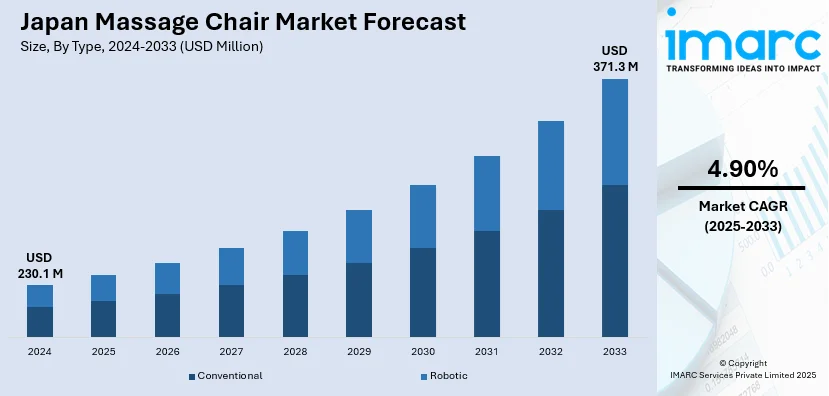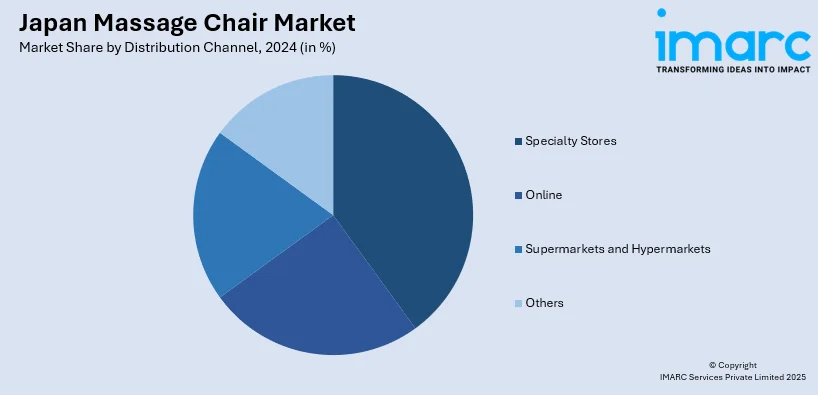
Japan Massage Chair Market Size, Share, Trends and Forecast by Type, Product Type, Distribution Channel, End-Use, and Region, 2025-2033
Japan Massage Chair Market Overview:
The Japan massage chair market size reached USD 230.1 Million in 2024. Looking forward, IMARC Group expects the market to reach USD 371.3 Million by 2033, exhibiting a growth rate (CAGR) of 4.90% during 2025-2033. The market is driven by an aging population seeking pain relief, rising health awareness, and tech advancements including AI and IoT in smart chairs. Urbanization enhances demand for compact designs, while increasing disposable incomes and wellness trends further propel growth. Government support for healthcare products is also expanding the Japan massage chair market share.
|
Report Attribute
|
Key Statistics
|
|---|---|
|
Base Year
|
2024
|
|
Forecast Years
|
2025-2033
|
|
Historical Years
|
2019-2024
|
| Market Size in 2024 | USD 230.1 Million |
| Market Forecast in 2033 | USD 371.3 Million |
| Market Growth Rate 2025-2033 | 4.90% |
Japan Massage Chair Market Trends:
Growing Demand for Smart and Connected Massage Chairs
The market is experiencing a rise in demand for smart and connected models, driven by advancements in technology and increasing consumer preference for convenience. Modern massage chairs now integrate AI, IoT, and app-based controls, allowing users to customize sessions via smartphones or voice assistants. Features including body scanning, posture detection, and personalized massage programs enhance user experience, making these chairs more appealing to tech-savvy consumers. Additionally, some high-end models offer health monitoring, tracking metrics such as heart rate and stress levels, aligning with Japan’s growing wellness trends. The aging population is further supporting the Japan massage chair market growth, as elderly consumers seek therapeutic solutions for pain relief and mobility improvement. Japan's elderly population has reached 36.25 million, or 29.3% of the population, punctuating a finding that the number is expected to jump to 34.8% by 2040. There are more than 9.1 million older adults who are still working, and hence the need for wellness and comfort products is growing. The aging population presents a valuable opening for the aid massage chair industry in Japan, catering to seniors' health and leisure needs during this demographic shift. Companies are investing in R&D to incorporate AI-driven adjustments and cloud-based updates, ensuring long-term usability. As smart home ecosystems expand, massage chairs with seamless connectivity are expected to dominate the market, appealing to both younger and older demographics seeking high-tech relaxation solutions.

Integration of Eco-Friendly and Sustainable Materials
Sustainability is becoming a key trend in the market, with manufacturers increasingly using eco-friendly materials such as recycled metals, biodegradable fabrics, and energy-efficient components. A recent industry report highlights progress in emissions and waste reduction, with greenhouse gas emissions down 19% since 2013 and a municipal waste level two-thirds lower than the OECD average. However, Japan is facing growing pressure to phase out fossil fuels and improve recycling, especially plastics, to meet its target of net zero by 2050. Such essential changes provide new avenues for Japan's massage chair industry to use eco-friendly materials and contribute to the nation's sustainability goals as well. Environmentally conscious consumers are driving demand for products that align with Japan’s carbon-neutral goals. Brands are also adopting sustainable production practices, including reduced packaging waste and energy-saving modes in chair operations. Some high-end models now feature solar-powered options or low-energy consumption motors, appealing to green-minded buyers. Government incentives for eco-friendly products further support this shift. As corporate social responsibility gains importance, companies that prioritize sustainability in design and manufacturing are likely to gain a competitive edge, creating a positive Japan massage chair market outlook.
Japan Massage Chair Market Segmentation:
IMARC Group provides an analysis of the key trends in each segment of the market, along with forecasts at the country level for 2025-2033. Our report has categorized the market based on type, product type, distribution channel, and end-use.
Type Insights:
- Conventional
- Robotic
The report has provided a detailed breakup and analysis of the market based on the type. This includes conventional and robotic.
Product Type Insights:
- Inversion Massage Chairs
- Zero Gravity Massage Chairs
- Targeted Massage Products
- Others
A detailed breakup and analysis of the market based on the product type have also been provided in the report. This includes inversion massage chairs, zero gravity massage chairs, targeted massage products, and others.
Distribution Channel Insights:

- Specialty Stores
- Online
- Supermarkets and Hypermarkets
- Others
The report has provided a detailed breakup and analysis of the market based on the distribution channel. This includes specialty stores, online, supermarkets and hypermarkets, and others.
End-Use Insights:
- Commercial
- Residential
A detailed breakup and analysis of the market based on the end-use have also been provided in the report. This includes commercial and residential.
Regional Insights:
- Kanto Region
- Kansai/Kinki Region
- Central/ Chubu Region
- Kyushu-Okinawa Region
- Tohoku Region
- Chugoku Region
- Hokkaido Region
- Shikoku Region
The report has also provided a comprehensive analysis of all the major regional markets, which include Kanto Region, Kansai/Kinki Region, Central/ Chubu Region, Kyushu-Okinawa Region, Tohoku Region, Chugoku Region, Hokkaido Region, and Shikoku Region.
Competitive Landscape:
The market research report has also provided a comprehensive analysis of the competitive landscape. Competitive analysis such as market structure, key player positioning, top winning strategies, competitive dashboard, and company evaluation quadrant has been covered in the report. Also, detailed profiles of all major companies have been provided.
Japan Massage Chair Market Report Coverage:
| Report Features | Details |
|---|---|
| Base Year of the Analysis | 2024 |
| Historical Period | 2019-2024 |
| Forecast Period | 2025-2033 |
| Units | Million USD |
| Scope of the Report |
Exploration of Historical Trends and Market Outlook, Industry Catalysts and Challenges, Segment-Wise Historical and Future Market Assessment:
|
| Types Covered | Conventional, Robotic |
| Product Types Covered | Inversion Massage Chairs, Zero Gravity Massage Chairs, Targeted Massage Products, Others |
| Distribution Channels Covered | Specialty Stores, Online, Supermarkets and Hypermarkets, Others |
| End-Uses Covered | Commercial, Residential |
| Regions Covered | Kanto Region, Kansai/Kinki Region, Central/ Chubu Region, Kyushu-Okinawa Region, Tohoku Region, Chugoku Region, Hokkaido Region, Shikoku Region |
| Customization Scope | 10% Free Customization |
| Post-Sale Analyst Support | 10-12 Weeks |
| Delivery Format | PDF and Excel through Email (We can also provide the editable version of the report in PPT/Word format on special request) |
Key Questions Answered in This Report:
- How has the Japan massage chair market performed so far and how will it perform in the coming years?
- What is the breakup of the Japan massage chair market on the basis of type?
- What is the breakup of the Japan massage chair market on the basis of product type?
- What is the breakup of the Japan massage chair market on the basis of distribution channel?
- What is the breakup of the Japan massage chair market on the basis of end-use?
- What is the breakup of the Japan massage chair market on the basis of region?
- What are the various stages in the value chain of the Japan massage chair market?
- What are the key driving factors and challenges in the Japan massage chair?
- What is the structure of the Japan massage chair market and who are the key players?
- What is the degree of competition in the Japan massage chair market?
Key Benefits for Stakeholders:
- IMARC’s industry report offers a comprehensive quantitative analysis of various market segments, historical and current market trends, market forecasts, and dynamics of the Japan massage chair market from 2019-2033.
- The research report provides the latest information on the market drivers, challenges, and opportunities in the Japan massage chair market.
- Porter's five forces analysis assist stakeholders in assessing the impact of new entrants, competitive rivalry, supplier power, buyer power, and the threat of substitution. It helps stakeholders to analyze the level of competition within the Japan massage chair industry and its attractiveness.
- Competitive landscape allows stakeholders to understand their competitive environment and provides an insight into the current positions of key players in the market.
Need more help?
- Speak to our experienced analysts for insights on the current market scenarios.
- Include additional segments and countries to customize the report as per your requirement.
- Gain an unparalleled competitive advantage in your domain by understanding how to utilize the report and positively impacting your operations and revenue.
- For further assistance, please connect with our analysts.
 Request Customization
Request Customization
 Speak to an Analyst
Speak to an Analyst
 Request Brochure
Request Brochure
 Inquire Before Buying
Inquire Before Buying




.webp)




.webp)












